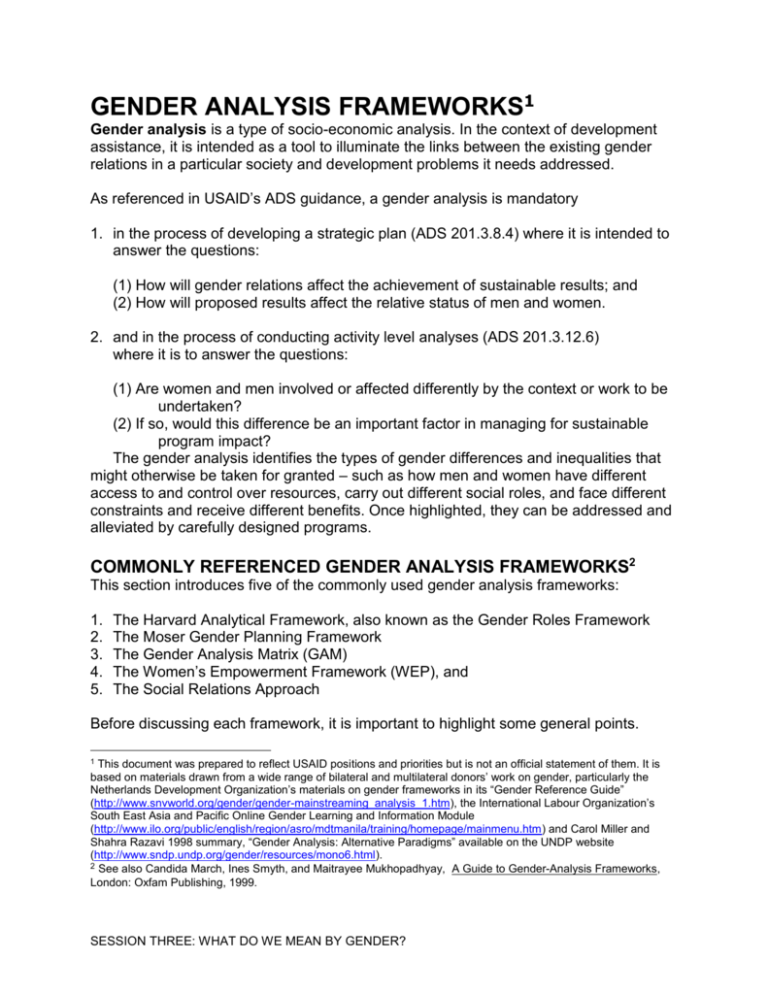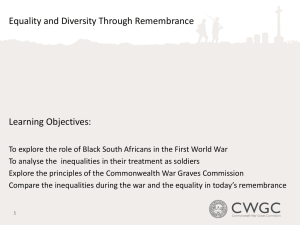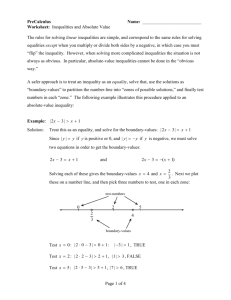gender analysis frameworks - GATE: Why Address Gender Inequalities
advertisement

GENDER ANALYSIS FRAMEWORKS1 Gender analysis is a type of socio-economic analysis. In the context of development assistance, it is intended as a tool to illuminate the links between the existing gender relations in a particular society and development problems it needs addressed. As referenced in USAID’s ADS guidance, a gender analysis is mandatory 1. in the process of developing a strategic plan (ADS 201.3.8.4) where it is intended to answer the questions: (1) How will gender relations affect the achievement of sustainable results; and (2) How will proposed results affect the relative status of men and women. 2. and in the process of conducting activity level analyses (ADS 201.3.12.6) where it is to answer the questions: (1) Are women and men involved or affected differently by the context or work to be undertaken? (2) If so, would this difference be an important factor in managing for sustainable program impact? The gender analysis identifies the types of gender differences and inequalities that might otherwise be taken for granted – such as how men and women have different access to and control over resources, carry out different social roles, and face different constraints and receive different benefits. Once highlighted, they can be addressed and alleviated by carefully designed programs. COMMONLY REFERENCED GENDER ANALYSIS FRAMEWORKS2 This section introduces five of the commonly used gender analysis frameworks: 1. 2. 3. 4. 5. The Harvard Analytical Framework, also known as the Gender Roles Framework The Moser Gender Planning Framework The Gender Analysis Matrix (GAM) The Women’s Empowerment Framework (WEP), and The Social Relations Approach Before discussing each framework, it is important to highlight some general points. 1 This document was prepared to reflect USAID positions and priorities but is not an official statement of them. It is based on materials drawn from a wide range of bilateral and multilateral donors’ work on gender, particularly the Netherlands Development Organization’s materials on gender frameworks in its “Gender Reference Guide” (http://www.snvworld.org/gender/gender-mainstreaming_analysis_1.htm), the International Labour Organization’s South East Asia and Pacific Online Gender Learning and Information Module (http://www.ilo.org/public/english/region/asro/mdtmanila/training/homepage/mainmenu.htm) and Carol Miller and Shahra Razavi 1998 summary, “Gender Analysis: Alternative Paradigms” available on the UNDP website (http://www.sndp.undp.org/gender/resources/mono6.html). 2 See also Candida March, Ines Smyth, and Maitrayee Mukhopadhyay, A Guide to Gender-Analysis Frameworks, London: Oxfam Publishing, 1999. SESSION THREE: WHAT DO WE MEAN BY GENDER? In addition to those discussed here, there are other models for collecting and analyzing gender-relevant information, and ways to put that analysis into effect in development interventions. No single framework provides an appropriate way to address all development problems. Each model reflects a set of assumptions about how gender is constituted and the importance of understanding gender issues to achieve successful development outcomes. Some emphasize equity or equality as the key outcome, and do not address other development objectives. Program managers can learn to identify these assumptions to choose the most appropriate model for their specific needs. The different institutional settings of the multi-lateral and bilateral development agencies, the foundations, NGOs, and developing and transition country government systems call for adaptation of different gender analysis frameworks. Not all models work equally well in every organization; many were designed by specific organizations and are not easy to adapt to other institutional programs. Some are more research oriented and are difficult to use in implementation; others are focused only on a particular implementation style and may omit data useful to other approaches. Each model was developed at a particular point in time. Not all have been modified to reflect changes in the way we think about gender or the way in which development priorities and approaches have changed. In hiring consultants to carry out gender analyses, to clarify which, if any, framework the consultant follows. Some follow one particular model; others use a combination of methods depending on the situation at hand. THE HARVARD ANALYTICAL FRAMEWORK OR GENDER ROLES FRAMEWORK The Harvard Analytical Framework (sometimes referred to as the “Gender Roles Framework” or the “Gender Analysis Framework”) was developed by researchers at the Harvard Institute of International Development (HIID) in collaboration with USAID’s Office of Women in Development. It represents one of the earliest efforts to systematize attention to both women and men and their different positions in society. It is based upon the position that allocating resources to women as well as men in development efforts makes economic sense and will make development itself more efficient – a position labelled as the “efficiency approach.” Key to the Harvard Analytical Framework is adequate data collection at the individual and household level, and it adapts well to agricultural and other rural production systems. Data is collected on men’s and women’s activities which are identified as either “reproductive” or “productive” types, and is then considered according to how those activities reflect access to and control over income and resources, thereby “highlighting the incentives and constraints under which men and women work in order to anticipate how projects will impact their productive and reproductive activities as well SESSION THREE: WHAT DO WE MEAN BY GENDER? as the responsibilities of other household members.”3 Data is collected in three components: an activity profile, an access and control profile that looks at resources and benefits, and a list of influencing factors. The approach helps those with little understanding of gender analysis useful ways of documenting information in the field: according to one donor, “It makes men’s and women’s work visible.”4 Because the approach emphasizes gender-awareness and does not seek to identify the causes of gender inequalities, it “offers little guidance on how to change existing gender inequalities.”5 There is the expectation that having good data on gender will, on its own, allow practitioners to address gender concerns in their activities; it assumes that both the problem and the solutions are technical ones. Compared to more recent and more participatory approaches, the Harvard method does not involve informants in describing their own views of the development problems they face. Key Resources: Overholt, C., M. Anderson, K. Cloud, and J. Austin 1985 Gender Roles in Development Projects: Cases for Planners. West Hartford, CT: Kumarian Press; and Rao, Aruna, Mary B. Anderson, and Catherine Overholt 1991 Gender Analysis in Development Planning: A Case Book. West Hartford, CT: Kumarian Press. THE MOSER GENDER PLANNING FRAMEWORK This framework, developed by Caroline Moser, links the examination of women’s roles to the larger development planning process. The approach introduces the idea of women’s “three roles” in production, reproduction, and community management (see below), and the implication that these roles have for women’s participation in the development process. In making these links, both between women and the community, and between gender planning and development planning more broadly, Moser’s framework encompasses both the technical and political aspects of gender integration into development. The framework is composed of several components (or tools). In the first, the triple roles of women are identified by mapping the activities of household members (including children) over the course of twenty-four hours. Reproductive Roles: Childbearing and rearing, domestic tasks that guarantee the maintenance and reproduction of the current and future work force (e.g., cooking, cleaning, etc.) Productive Roles: Work done for remuneration, in cash or kind. (e.g., wage labor, farming, crafts, etc. Netherlands Development Organization, “Gender Reference Guide.” International Labour Organization, “Online Gender Learning and Information Module.” 5 International Labour Organization, “Online Gender Learning and Information Module.” 3 4 SESSION THREE: WHAT DO WE MEAN BY GENDER? Community Management Roles: Work that supports collective consumption and maintenance of community resources (e.g., local government, irrigation systems management, education, etc.) The second component identifies and assesses gender needs, distinguishing between practical needs (to address inadequate living conditions) and strategic needs (for power and control to achieve gender equality). The third component, or tool, disaggregates information about access to and control over resources within the household by sex: who makes decisions about the use of different assets. The fourth component identifies how women manage their various roles, and seeks to clarify how planned interventions will affect each one. Finally, the WID/GAD policy matrix evaluates how different planning approaches (welfare, equity, anti-poverty, efficiency, and empowerment) have addressed the triple roles and women’s practical and strategic needs. Key Resources: Moser, Caroline O.N. 1993 Gender Planning and Development: Theory, Practice, and Training. London: Routledge. GENDER ANALYSIS MATRIX The gender analysis matrix was developed by A. Rani Parker as a quickly employed tool to identify how a particular development intervention will affect women and men. It uses a community-based technique to elicit and analyze gender differences and to challenge a community’s assumptions about gender. Unlike some of the other tools described, this one is explicitly intended for use by the community for self-identification of problems and solutions. The principles of the Gender Analysis Matrix are: All requisite knowledge for gender analysis exists among the people whose lives are the subject of the analysis Gender analysis does not require the technical expertise of those outside the community being analyzed, except as facilitators Gender analysis cannot be transformative unless the analysis is done by the people being analyzed.6 Each project objective is analyzed at four levels of society: women, men, household and community by various groups of stakeholders. They carry out the analysis by discussing each project objective in terms of how it impacts on men’s and women’s labor practices, 6 Quoted from the Global Development Research Center website, http://www.gdrc.org/gender/framework/matrix.html. SESSION THREE: WHAT DO WE MEAN BY GENDER? time, resources, and other socio-cultural factors, such as changes in social roles and status. Key Resources: Parker, Rani. 1993 Another Point of View: A Manual on Gender Analysis Training for Grassroots Workers. New York: UNIFEM. WOMEN’S EMPOWERMENT FRAMEWORK The Women’s Empowerment Framework was developed by Sara Hlupekile Longwe, a gender expert from Lusaka, Zambia. Her model is explicitly political, arguing that women’s poverty is the consequence of oppression and exploitation (rather than lack of productivity), and that to reduce poverty women must be empowered. The framework postulates five progressively greater levels of equality that can be achieved (listed from highest to lowest): 1. Control – equal control over in decision-making over factors of production. 2. Participation – equal participation in decision-making processes related to policymaking, planning and administration. 3. Conscientisation – attaining equal understanding of gender roles and a gender division of labor that is fair and agreeable. 4. Access – equal access to the factors of production by removing discriminatory provisions in the laws. 5. Welfare – having equal access to material welfare (food, income, medical care). The framework is intended to assist planners to identify what women’s equality and empowerment would mean in practice, and to determine to what extent a development intervention supports greater empowerment. The tool examines elements of a project’s design or a sectoral program to determine to see if it affects the five different levels of equality either negatively, neutrally, or positively. SOCIAL RELATIONS APPROACH The social relations framework was created by Naila Kabeer at the Institute of Development Studies in Sussex, UK. It draws on explicitly structural feminist roots. It is broader than earlier approaches, locating the family and household within the network of social relations connecting them to the community, market, and state. Kabeer writes that the triple roles model formulated by Moser is insufficiently attentive to “the fact that most resources can be produced in a variety of institutional locations (households, markets, states, and communities) so that the same resources may be produced through very different social relations.”7 The Social Relations Approach shows how gender and other inequalities are created and reproduced within structural and institutional factors, and then to design policies that can enable women to work to change those factors that constrain them. 7 Quoted in Miller and Ravazi, http://www.sdnp.undp.org/gender/resources/mono6.html SESSION THREE: WHAT DO WE MEAN BY GENDER? The Social Relations Approach asserts that:8 Development is a process for increasing human well-being (survival, security and autonomy), and not just about economic growth or increased productivity. Social relations determine peoples roles, rights, responsibilities and claims over others. Institutions produce and maintain social inequalities, including gender inequalities. Four key institutions are the state, the market, the community and the family. These have rules (how things get done), resources (what is used and/or produced), people (who is in/out, who does what), activities (what is done), and power (who decides, and whose interests are served), all of which engender social relations. The operation of institutions reflect different gender policies. Gender policies are differ according to the extent they recognise and address gender issues: genderblind policies, gender-aware policies, gender-neutral policies, gender-specific policies, and gender-redistributive policies. Analysis for planning needs to examine whether immediate, underlying, and/or structural factors are responsible for the problems, and what their effects on those involved. Key Resource: Kabeer, Naila. 1994. Reversed Realities: Gender Hierarchies in Development Thought. London, UK: Verso. FOUR DIMENSIONS OF GENDER RELATIONS9 USAID has built a requirement for gender mainstreaming into its operations manual, the Automated Directive System (ADS). It requires that all USAID operating units – whether at headquarters or in the field -- examine two key questions with regard to gender issues when engaged in strategic planning: (1) How will gender relations affect the achievement of sustainable results; and, (2) How will proposed results affect the relative status of men and women? To answer the questions, you must be able to describe the different roles of men and women in the area in which you are working, as well as the relationship and balance between them and institutional structures that support them.10 In the gender analysis framework presented here, key aspects of gender relations are described across main dimensions of social life to help clarify how gender differences 8 Drawn from the Netherlands Development Organization’s, “Gender Reference Guide.” 9 The Domains Framework for Gender Analysis on which this is based draws on the principles of the other frameworks described elsewhere, but has been refined specifically for use with USAID programs and projects in large part by Deborah Rubin and Deborah Caro of Cultural Practice LLC under USAID contracts (the WID IQC and the Health Policy Initiative). Many of the components of this approach are available with a health focus on the Interagency Gender Working Group (IGWG) website, www.igwg.org along with many other training materials on gender. 10 Automated Directive System (ADS) Chapter 201.3.8.4 Gender Analysis [excerpted in Section 2 of this training handbook]. SESSION THREE: WHAT DO WE MEAN BY GENDER? may create constraints and/or opportunities that may affect your research and /or development results. These four dimensions do not encompass the total range of human activity and there is some overlap among them, but they nevertheless provide a conceptual framework for addressing to the two questions posed by the ADS (listed above). This gender analysis framework is one of many that have been used in development research and implementation.11 It facilitates both the data collection about and the analysis of how gender relations operate in different dimensions of social life and development activities. It also helps to identify whether there are specific gender-based structural and institutional constraints that affect the relative status and opportunities open to men and women that can be addressed by development activities. The expectation is that this exercise can help researchers move beyond simply disaggregating data and process indicators by sex. By more carefully considering the questions posed by the USAID operations manual, USAID-funded research will be able to provide better information about the current status of gender relations as well as better information about how development programs are affecting the relative status of men and women so that future interventions can help to overcome gender constraints and achieve the Millennium Development Goals of reducing hunger and poverty while enhancing gender equality. ACCESS TO FACTORS OF PRODUCTION AND ENTERPRISE DEVELOPMENT This dimension describes the social relationships that shape access to the resources that are necessary to be a fully active and productive (socially, economically, and politically) participant in society, including access to land, labor, capital, natural resources, education, employment, and information. What are the resources needed to participate in agricultural value chains? Do men and women differ in their ability to mobilize those resources? How? KNOWLEDGE AND BELIEFS Men and women are socialized to learn about different aspects of life. This dimension covers who knows what and how they know it, describing how these domains of knowledge differ by gender category. What areas of agricultural work and enterprise development are most likely to be learned by boys and men? Are men expected to grow certain crops and not others? Are some crops solely the province of women? Different cultures have belief systems about gender that shape perceptions about what Beliefs (ideology) that shape gender identities and behavior, defining what are considered appropriate for men and women, boys or girls in how they go about their daily lives. PRACTICES AND PARTICIPATION SESSION THREE: WHAT DO WE MEAN BY GENDER? Gender defines many aspects of how people behave and act. For example, gender affects the division of labor in the household and the kinds of jobs that people take; it affects educational opportunities. Ideas about gender shape who is allowed to travel in different locations, by oneself or in groups, and at what times they are allowed to be there. Gender influences participation in activities, meetings, political processes, services, and training courses. LAWS, POLICIES, AND REGULATORY INSTITUTIONS Gender influences the way people are regarded by and treated by both customary law and the formal legal code and judicial system. Gender affects rights to legal documents, ownership and inheritance, reproductive choice and personal safety, representation, and due process. POWER is a cross-cutting component in each of these four dimensions. SESSION THREE: WHAT DO WE MEAN BY GENDER?









